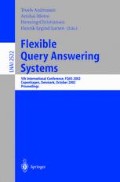Abstract
We describe a formal design of a hybrid language and show that it provides a suitable basis for representing and interacting with ontologies. We specify ontologies and query them with a clear logical semantics. The proposed language combines the expressive power of description logics and rules.
Access this chapter
Tax calculation will be finalised at checkout
Purchases are for personal use only
Preview
Unable to display preview. Download preview PDF.
References
Alessandro Artale, Enrico Franconi, Nicola Guarino, and Luca Pazzi. Part-Whole Relations in Object-Centered Systems: An Overview. Data & Knowledge Engineering, 20(3):347–383, December 1996.
Franz Baader. Using Automata Theory for Characterizing the Semantics of Terminological Cycles. Annals of Mathematic and Artificial Intelligence, 18:175–219, 1996.
Franz Baader and Ulrike Sattler. Number Restrictions on Complex Roles in Description Logics: A Preliminary Report. In Proceedings of the 5th International Conference on Principles of Knowledge Representation and Reasoning (KR’96), Cambridge, Massachusetts, USA, pages 328–339, November 1996.
Alexander Borgida and Peter Patel-Schneider. A Semantic and Complete Algorithm for Subsumption in the CLASSIC Description Logic. Journal of Artificial Intelligence Research, 1:277–308, 1994.
Martin Buchheit, Francesco M. Donini, and Andrea Schaerf. Decidable Reasoning in Terminological Knowledge Representation Systems. Journal of Artificial Intelligence Research, 1:109–138, 1993.
B. Chandrasekaran, John R. Josephson, and V. Richard Benjamins. What Are Ontologies and Why Do We Need Them. IEEE Intelligent Systems, 14(1):20–26, january/february 1999.
William W. Cohen and Haym Hirsh. Learning the CLASSIC Description Logic: Theoretical and Experimental Results. In Proceedings of the 4th International Conference on Principles of Knowledge Representation and Reasoning (KR’94), Bonn, Germany, pages 121–133, May 1994.
Francesco M. Donini, Maurizio Lenzerini, Daniele Nardi, and Werner Nutt. The Complexity of Concept Languages. Technical Report RR-95-07, Deutsches Forschunggszentrum für Künstliche Intelligenz (DFKI), Kaiserslautern, Germany, June 1995.
Francesco M. Donini, Maurizio Lenzerini, Daniele Nardi, and Andrea Schaerf. ALlog: Integrating Datalog and Description Logics. Journal of Intelligent Information Systems, 10(3):227–252, 1988.
Francesco M. Donini, Maurizio Lenzerini, Daniele Nardi, and Andrea Schaerf. Reasoning in Description Logics. In Foundation of Knowledge Representation. Cambrige University Press, 1995.
Adam Farquhar, Richard Fikes, and James Rice. The Ontolingua Server: a Tool for Collaborative Ontology Construction. In Proceedings of the 10th Knowledge Acquisition for Knowledge-Based Systems Workshop, Ban., Canada, nov 1996.
Nicola Guarino. Formal Ontology in Information Systems. IOS Press, 1998.
Michael Kifer and James Wu. A Logic for Object-Oriented Logic Programming (maier’s o-logic revisited). In Proceedings of the 1989 Symposium on Principles of Database Systems (PODS’89), Philadelphia, Pennsylvania, pages 379–393, March 1989.
Ralf Küsters. Characterizing the Semantics of Terminological Cycles in ALN Using Finite Automata. In Proceedings of the 6th International Conference on Principles of Knowledge Representation and Reasoning (KR’98), Trento, Italy, pages 499–511, June 1998.
Alon Y. Levy and Marie-Christine Rousset. Combining Horn Rules and Description Logics in CARIN. Artificial Intelligence, 104(1–2):165–209, 1998.
D. A. B. Lindberg, B. L. Humphreys, and A. T. McCray. The Unified Medical Language System. Methods of Information in Medicine, 1993.
Margarida Mamede and Luis Monteiro. A Contraint Logic Programming Scheme for Taxonomic Reasoning. In Krzysztof R. Apt, editor, Proceedings of the Joint International Conference and Symposium on Logic Programming (JICSLP’92), Washington, DC, pages 255–269. MIT Press, ISBN0-262-51064-2, 1992.
Deborah L. McGuiness. Conceptual Modeling for Distributed Ontology Environments. In Proceedings of the 8th International Conference on Conceptual Structures Logical, Linguistic, and Computational Issues, Darmstadt, Germany, august 2000.
Deborah L. McGuiness, Richard Fikes, James Rice, and Steve Wilder. An Environment for Merging and Testing Large Ontologies. In Proceedings of the 7th International Conference on Principles of Knowledge Representation and Reasoning (KR’2000), Breckenridge, Colorado, USA, april 2000.
Prasenjit Mitra, Gio Wiederhold, and Martin Kersten. A Graph-Oriented Model for Articulation of Ontology Interdependencies. In Proceedings of the International Conference on Extended Database Technology (EDBT’2000), Konstanz, Germany, LNCS. Springer Verlag, march 2000.
Bernhard Nebel. Reasoning and Revision in Hybrid Representation Systems. LNCS-422. Springer-Verlag, 1990.
DA. L. Rector, W. A. Nowlan, S. Kay, C. A. Goble, and T. J. Howkins. A Framework for Modeling the Electronic Medical Record. Methods of Information in Medicine, 1993.
Manfred Schmidt-Schauβ and Gert Smolka. Attributive Concept Descriptions with Complements. Artificial Intelligence, 48(1):1–26, 1991.
G. van Heijst, A. T. Schreiber, and B. J. Wielinga. Using Explicit Ontologies in KBS Development. International Journal of Human and Computer Studies, 1996.
Author information
Authors and Affiliations
Editor information
Editors and Affiliations
Rights and permissions
Copyright information
© 2002 Springer-Verlag Berlin Heidelberg
About this paper
Cite this paper
Benslimane, D., Hacid, MS., Terzi, E., Toumani, F. (2002). A Class-Based Logic Language for Ontologies. In: Carbonell, J.G., Siekmann, J., Andreasen, T., Christiansen, H., Motro, A., Legind Larsen, H. (eds) Flexible Query Answering Systems. FQAS 2002. Lecture Notes in Computer Science(), vol 2522. Springer, Berlin, Heidelberg. https://doi.org/10.1007/3-540-36109-X_5
Download citation
DOI: https://doi.org/10.1007/3-540-36109-X_5
Published:
Publisher Name: Springer, Berlin, Heidelberg
Print ISBN: 978-3-540-00074-7
Online ISBN: 978-3-540-36109-1
eBook Packages: Springer Book Archive

